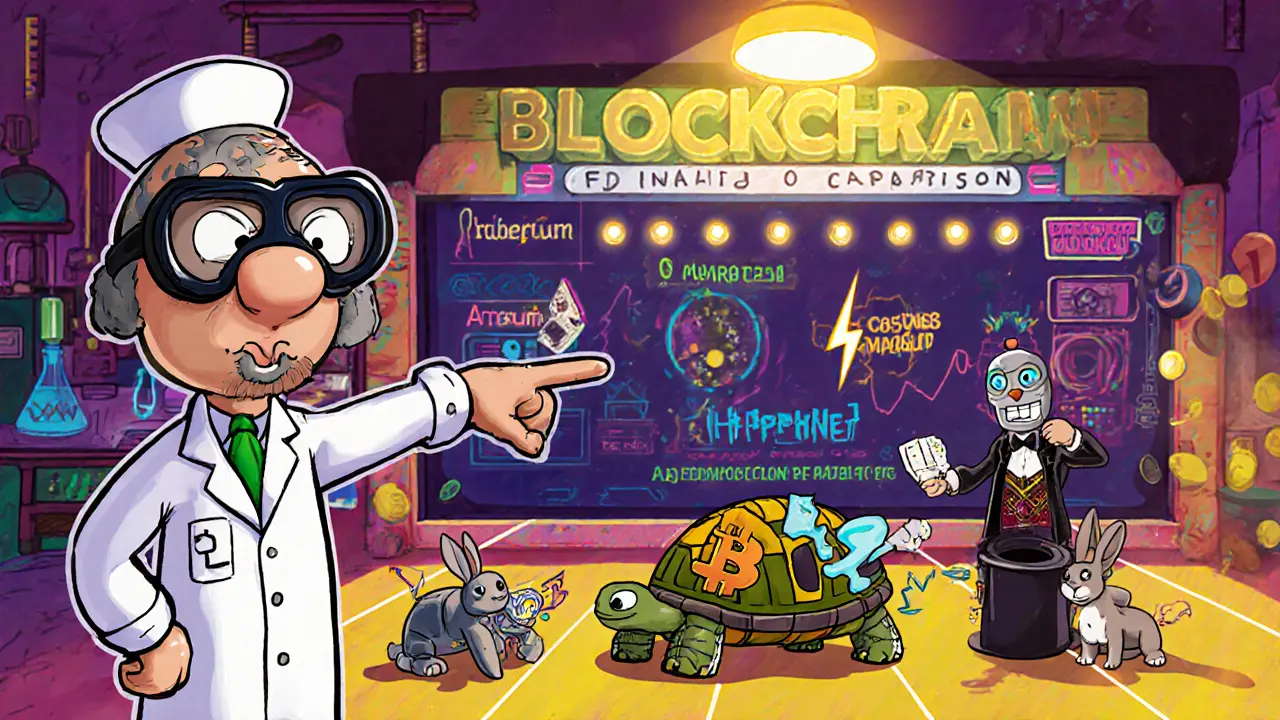
Blockchain Finality Comparison Tool
Finality Profile
Typical Time to Finality
Security Level
Integration Complexity
Best Use Cases
Trade-offs Summary
When a transaction lands on a ledger, the real question is: how soon can you trust that it will never be undone? The answer lies in blockchain finality the point at which a transaction becomes immutable and irreversible. Different networks reach that point in wildly different ways, and the choice can make or break a project’s security, speed, and regulatory compliance.
Key Takeaways
- Probabilistic finality (e.g., Bitcoin) needs multiple confirmations, leading to minutes‑to‑hours of delay.
- Deterministic finality (e.g., Tendermint‑based chains) offers instant irreversibility once a quorum signs.
- Economic finality (Ethereum’s PoS) combines staking incentives with a short but non‑instant finality window.
- Layer‑2 solutions inherit finality from their underlying Layer‑1, adding an extra coordination step.
- Time to Finality (TTF) directly impacts user experience, integration effort, and security risk.
1. The Four Main Finality Mechanisms
All public blockchains fall into one of four buckets:
- Probabilistic finality - Security grows with each new block. Bitcoin and most Proof‑of‑Work (PoW) chains belong here. The network never declares a block final; instead, the probability of reversal drops exponentially.
- Deterministic finality - Once a predefined set of validators reaches consensus, the block is final. Chains using Byzantine Fault Tolerance (BFT) like Ripple a BFT‑based payment network or those built on Tendermint a BFT consensus engine deliver instant finality.
- Economic finality - Validators stake tokens; slashing penalties enforce honesty. Ethereum’s Proof‑of‑Stake (PoS) is the flagship example. Two‑thirds of the active stake must agree before a block is considered final.
- Layer‑2 finality - L2 chains like Arbitrum an Optimistic Rollup on Ethereum or StarkNet a ZK‑Rollup on Ethereum do not run their own consensus; they inherit finality from the underlying L1.
2. Measuring Time to Finality (TTF)
TTF is the elapsed time from the moment a transaction is broadcast to the moment the network declares it final. It’s the single most actionable metric when comparing chains.
| Mechanism | Example Chains | Typical TTF | How Finality Is Achieved |
|---|---|---|---|
| Probabilistic | Bitcoin, Litecoin | ~60min (6 confirmations) | Each new block adds exponential security |
| Deterministic (BFT) | Ripple, Cosmos (Tendermint) | ~1‑3s | Quorum of validators signs off instantly |
| Economic (PoS) | Ethereum, Binance Smart Chain (post‑upgrade) | ~12‑30s | 2/3 of staked validators reach consensus |
| Layer‑2 (Optimistic) | Arbitrum, Optimism | ~7‑14days (challenge period) | Finality inherited after L1 finality + dispute window |
| Layer‑2 (ZK‑Rollup) | StarkNet, zkSync | ~30‑60s | Validity proofs posted to L1, finality follows L1 |
Notice the stark contrast: BFT chains settle in seconds, while Bitcoin needs an hour for high‑value certainty. The “challenge period” for Optimistic Rollups can feel endless for traders, which is why many move to ZK‑Rollups when speed matters.
3. Security Trade‑offs
Fast finality often means relying on a smaller validator set. That brings two risks:
- Sybil attacks - If a single entity controls >⅓ of the validator seats, they can halt or censor the chain.
- Economic attacks - In PoS, a malicious validator must stake enough to outweigh slashing penalties. Low‑stake networks are more vulnerable.
Probabilistic chains, by contrast, depend on raw hash power. The 51% attack model still applies, but the sheer cost of renting enough hashing power makes it prohibitive for large networks like Bitcoin. Smaller PoW chains, however, have been taken down with rented ASIC farms, confirming the warning from security researchers.
Deterministic finality chains mitigate this by rotating validator sets frequently and using stake‑bonded voting. For example, Cosmos zones rotate their validator set the group of nodes that sign blocks every block, making it harder for any single actor to accumulate influence.

4. Integration Complexity
From a developer’s perspective, the finality model dictates how you design your backend:
- Probabilistic chains - You must implement a “confirmation monitor” that watches for N additional blocks before crediting a transaction. The monitor adds latency and testing overhead.
- Deterministic chains - No special logic is needed; once the node reports the block as committed, you can trust it.
- Economic finality - You need to track both the “instant receipt” (when the block lands) and the “finalized receipt” (when the consensus checkpoint is published). Many SDKs expose a “finalized” flag that simplifies this.
- Layer‑2 solutions - Developers must understand both the L2 sequencer’s state and the underlying L1’s finality schedule. A common pattern is to wait for the L1 “finalized” flag before considering an L2 withdrawal final.
In practice, integrating with a BFT chain cuts development time by 30‑50% compared to Bitcoin‑style confirmation logic, according to several blockchain engineering surveys.
5. Real‑World Use Cases and Adoption Trends
Different finality profiles attract different applications:
- Store‑of‑value - Bitcoin’s long‑standing reputation outweighs its slow finality; custodians accept the hour‑scale confirmation window for large deposits.
- DeFi and high‑frequency trading - Platforms migrate to deterministic or ZK‑Rollup chains to lock in sub‑second settlement, eliminating arbitrage risk.
- Enterprise settlement - Companies building supply‑chain or identity solutions prefer BFT chains like Hyperledger Fabric a permissioned BFT blockchain for instant finality and permissioned governance.
- Gaming & NFTs - Instant finality improves user experience; many NFT marketplaces run on Solana a high‑throughput PoS chain with deterministic finality.
Layer‑2 rollups have exploded in volume: in 2024, combined L2 transactions on Ethereum surpassed the base layer, yet most users remain unaware that their funds are ultimately secured by Ethereum’s PoS finality schedule.
6. Choosing the Right Chain for Your Project
Ask yourself three questions:
- How fast must settlement be? If you need sub‑second confirmation, go BFT or ZK‑Rollup.
- What security level is non‑negotiable? High‑value assets generally favor Bitcoin‑style PoW or a well‑audited PoS with a large validator set.
- What’s your integration budget? Deterministic chains shave weeks off development; probabilistic chains demand more testing and monitoring.
Most startups start on Ethereum for its ecosystem, then layer‑2 onto a ZK‑Rollup for speed while still enjoying Ethereum’s economic finality. Legacy finance often builds on a BFT permissioned network for regulatory certainty.
7. Future Directions
Hybrid consensus models are emerging that try to give you the best of both worlds. Projects like Celestia a modular data availability layer that separates consensus from execution let developers pick their own finality engine on top of a shared data layer. Meanwhile, regulators are drafting rules that differentiate between “probabilistic” and “deterministic” finality for consumer protection, which could affect which chains qualify for certain financial services.
Frequently Asked Questions
What is the difference between probabilistic and deterministic finality?
Probabilistic finality, used by Bitcoin, never declares a block final; each new block reduces the chance of reversal. Deterministic finality, used by BFT chains, marks a block final the instant a quorum of validators signs it, leaving no chance for later reorgs.
How many Bitcoin confirmations are needed for a secure transaction?
Six confirmations (about 60minutes) are the industry standard for high‑value transfers. Lower‑value payments often settle with fewer confirmations, but risk grows if the number drops below three.
Can I get instant finality on Ethereum?
Not directly. Ethereum’s PoS blocks are proposed every 12seconds, but finality is only reached after the next checkpoint, usually within 12‑30seconds. For true instant finality you need a Layer2 solution that posts validity proofs, like a ZK‑Rollup.
Why do Layer‑2 rollups have longer finality than the base chain?
Optimistic rollups introduce a dispute window (often 7‑14days) to let validators challenge fraudulent state roots. ZK‑rollups avoid this by publishing cryptographic proofs, so their finality aligns closely with the underlying L1.
Which finality model is best for enterprise supply‑chain use?
Deterministic BFT chains are preferred because they provide immediate, legally defensible proof of settlement and avoid the monitoring overhead required by probabilistic chains.
Understanding the nuances of blockchain finality empowers you to pick the right network, size your risk, and design smoother user experiences. Whether you’re moving $1million of crypto or building a game that needs sub‑second token transfers, the finality mechanism is the foundation you can’t ignore.

Jessica Smith
October 2, 2025 AT 05:32Sonu Singh
October 2, 2025 AT 06:25sundar M
October 2, 2025 AT 18:52Stephanie Alya
October 3, 2025 AT 17:15Petrina Baldwin
October 3, 2025 AT 18:48Nisha Sharmal
October 4, 2025 AT 12:08Nick Carey
October 4, 2025 AT 12:14Peter Schwalm
October 5, 2025 AT 03:27Cyndy Mcquiston
October 5, 2025 AT 22:31Marianne Sivertsen
October 6, 2025 AT 22:27Abby Gonzales Hoffman
October 7, 2025 AT 02:09olufunmi ajibade
October 7, 2025 AT 15:34Karla Alcantara
October 8, 2025 AT 04:00Alex Horville
October 8, 2025 AT 23:47Shruti rana Rana
October 9, 2025 AT 05:30Rampraveen Rani
October 9, 2025 AT 16:19Ralph Nicolay
October 10, 2025 AT 09:01ashish ramani
October 10, 2025 AT 22:43Manish Gupta
October 11, 2025 AT 21:56Gabrielle Loeser
October 12, 2025 AT 08:55